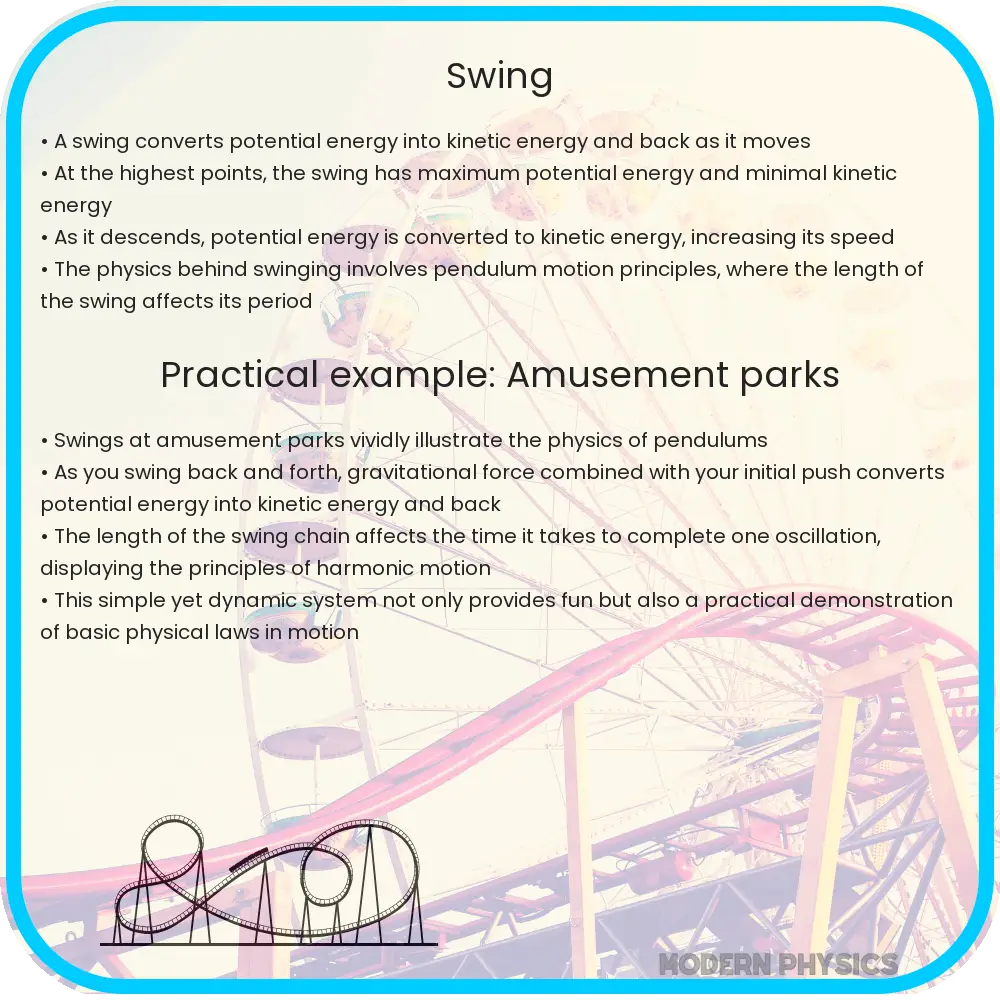Explore the fascinating physics of swing dynamics, delving into motion, forces, and energy with practical insights and real-world applications.

Understanding Swing Dynamics: Exploring Motion, Forces, and Energy Principles
The dynamics of a swing offer a fascinating glimpse into the principles of physics, particularly those involving motion, forces, and energy. By examining the mechanics of a swing, we can understand fundamental concepts in a practical and engaging way. This article delves into the underlying physics that govern the operation of a simple yet intriguing apparatus: the swing.
Motion: The Pendulum Effect
A swing is essentially a type of pendulum. When a person swings, they move back and forth in a curved path, much like a pendulum in a grandfather clock. This motion is a result of gravitational forces acting on the mass at the end of the swing (the person). The swing moves from its highest point (the peak of its arc) to the lowest point (directly beneath the suspension point) and back again. This to-and-fro motion, or oscillation, is a perfect example of periodic motion, where the swing moves in a regular and repeating pattern.
Forces at Play: Gravity and Tension
The primary forces acting on a swing are gravity and tension. Gravity constantly pulls the swinger downwards, while the tension in the swing’s ropes or chains provides the necessary centripetal force to keep the swinger moving in a curved path. At the lowest point of the swing, the force of gravity and the tension force are aligned, and the tension is at its maximum. As the swing rises, the tension decreases, and gravity starts to pull the swing back down.
Energy Transfer: Potential and Kinetic Energy
Energy plays a crucial role in the swinging motion. As the swing moves, energy is constantly being transferred between two forms: potential energy and kinetic energy. At the highest points of the swing’s arc, the swinger has maximum potential energy and minimum kinetic energy. This potential energy is due to the height of the swinger above the ground. As the swing descends, this potential energy is converted into kinetic energy—the energy of motion. At the lowest point of the swing, the kinetic energy is at its maximum, and the potential energy is at its minimum.
Understanding these principles not only enriches our appreciation for a common playground apparatus but also provides insight into more complex systems in physics. The next section will delve deeper into the mathematical relationships governing swing dynamics and their applications in real-world scenarios.
Mathematical Relationships in Swing Dynamics
The motion of a swing can be described using the principles of simple harmonic motion (SHM), a type of periodic motion. The period of a swing, or the time it takes to complete one full back and forth movement, depends primarily on the length of the swing. The formula for the period \( T \) of a simple pendulum is given by \( T = 2\pi\sqrt{\frac{l}{g}} \), where \( l \) is the length of the pendulum (or swing) and \( g \) is the acceleration due to gravity. This relationship shows that the period is independent of the mass of the swinger and the amplitude of the swing, as long as the amplitude is small.
Real-World Applications of Swing Dynamics
The principles observed in swing dynamics extend beyond playgrounds. They are fundamental in various fields such as engineering, astronomy, and even art. For example, pendulums are used in seismographs to record earth tremors. Clocks, especially traditional pendulum clocks, operate based on the regular periodic motion of a pendulum. In the realm of art, kinetic sculptures often utilize pendulum motions to create dynamic and captivating artworks.
Conclusion
The swing is a simple yet powerful tool for understanding fundamental physics concepts. Through the motion of swinging, we observe the interplay of forces and energy, witness the practical applications of periodic motion, and appreciate the elegance of simple harmonic motion. This exploration of swing dynamics not only provides us with a deeper understanding of physics but also demonstrates the beauty and interconnectedness of scientific principles in our everyday lives. Whether it’s a child enjoying a playground swing or a scientist examining the oscillations of a pendulum, the principles of motion, forces, and energy remain universally relevant and intriguing.
In conclusion, the study of swing dynamics serves as an exemplary model for exploring complex physics concepts in an accessible and engaging manner. It highlights how seemingly mundane experiences can be windows into the profound workings of the natural world. As we continue to explore and understand these principles, we gain a greater appreciation for the intricate and wonderful world of physics that surrounds us.
